Ներողություն ենք խնդրում կայքի մեքենայական թարգմանության հնարավոր սխալների համար
2.3. Extent of vegetation/ecosystem types
Creation of updated vegetation map – Ալլա Ալեքսանյանը (ՀՀ ԳԱԱ Ա. Թախտաջյանի անվան բուսաբանության ինստիտուտ)
Digitizing of vegetation map – Վարդան Ասատրյանը (ՀՀ ԳԱԱ կենդանաբանության և հիդրոէկոլոգիայի գիտական կենտրոն)
GIS modeling, analysis, and presentation of results – Էդուարդ Կազակով (NextGIS OÜ, Էստոնիա)
Արդյունքների վերլուծություն և ներկայացում – Ելենա Բուկվարևա (ԲԿԿ-Հայաստան)
The assessment of the extent of natural vegetation zones was made based on a vegetation map created by the project experts Alla Aleksanyan and Vardan Asatryan (Fig. 1). The map was created based on Barseghyan (2007) and other materials. 
Figure 1. Zones of potential vegetation
The current natural area of vegetation zones is defined as the potential area of a given vegetation type minus cropland and built-up areas based on ESRI land cover data 2023 (Fig. 2). Figure 2. Natural areas of vegetation zones
Figure 2. Natural areas of vegetation zones
Academic vegetation maps cannot reflect small patches of tree cover located within non-forest zones. In Armenia, such patches are typically associated with specific landforms— such as canyons, gorges, and slopes — where atypical conditions for non-forest zones allow tree vegetation to persist. However, these tree cover patches are visible in land cover datasets. Integrating the vegetation map with land cover data makes it possible to account for forest distribution beyond the typical forest vegetation zone (Fig. 3).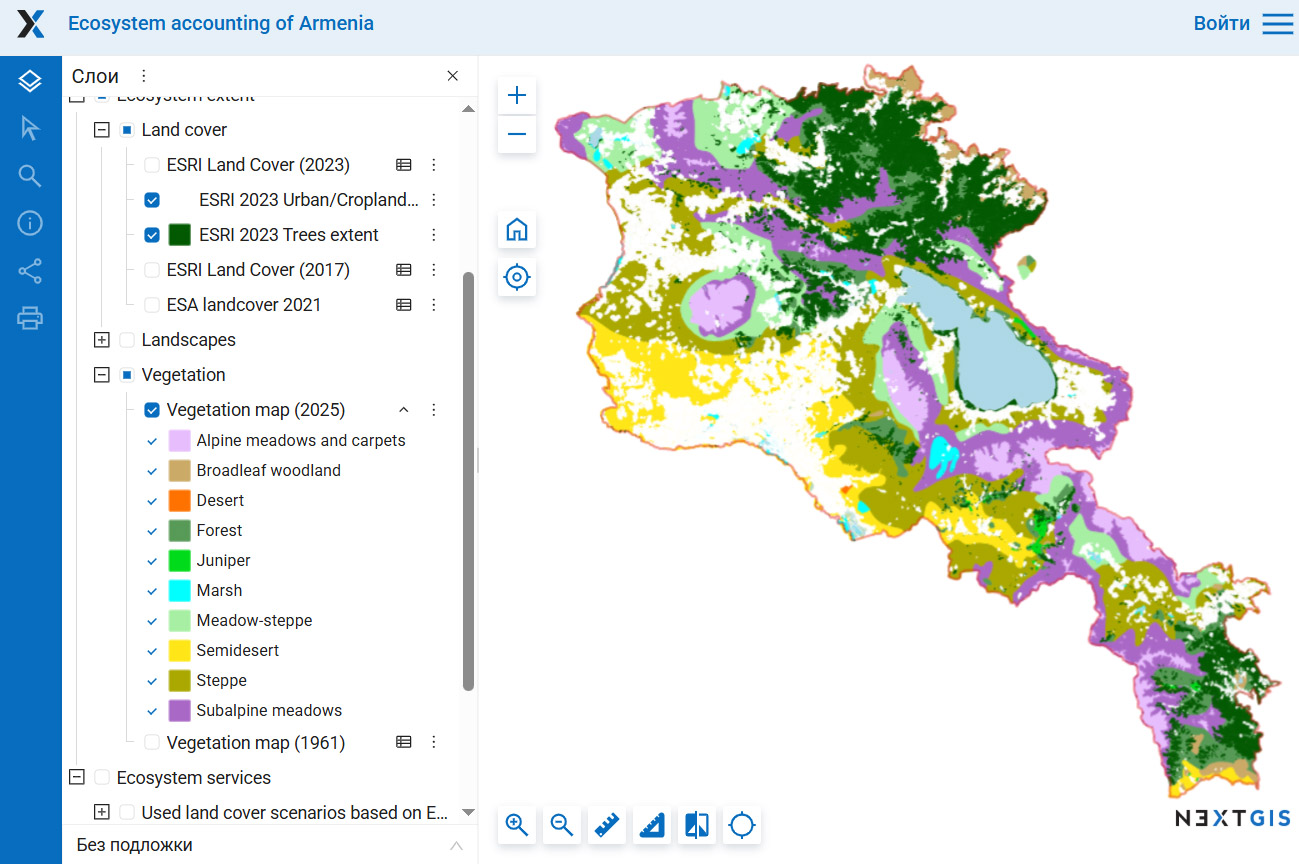
Figure 3. Vegetation, including current tree cover. For detailed maps see sections Ecosystem Extent/Vegetation/Vegetation map 2025
1. Extent of vegetation zones and current vegetation
According to ESRI data, the most human-transformed vegetation zone is semi-desert, where 57% of natural areas remain. It is followed by marshes and steppe with 71% and 76% of natural areas remaining, respectively. Tree cover occupies more than 40% of the forest zone and more than 20% of the broadleaf woodland zone. Significant forest patches are also present in subalpine meadows, meadow-steppe, and steppe zones. In the remaining zones, the tree cover identified by ESRI occupies a very small area — from 0 to 4 km². In the marsh zone, water bodies occupy a substantial area (Lake Sevan is excluded from the analysis). Figure. 4. Share of land cover classes in vegetation zones, %
Figure. 4. Share of land cover classes in vegetation zones, %
Table 1. Current area of land cover classes across vegetation zones, km2
| Ծառեր | Range-land | Մերկ գետնին | Ձյուն/Սառույց | Water/ flooded veg. | Մշակաբույսեր | Built area | No data/ clouds | Ընդամենը | Share of natural LC classes,% | |
| Alpine vegeta-tion | 0.61 | 1632.30 | 10.32 | 11.65 | 1.97 | 3.46 | 0.78 | 2.83 | 1663.92 | 100 |
| Ենթալպյան մարգագետիններ | 254.58 | 4266.55 | 5.53 | 0.27 | 3.03 | 84.53 | 24.84 | 19.79 | 4659.12 | 98 |
| Մարգագետնատափաստան | 76.39 | 2549.78 | 0.22 | 0.04 | 7.25 | 451.65 | 91.45 | 22.66 | 3199.42 | 83 |
| Տափաստանային | 94.59 | 5217.84 | 3.25 | 0.00 | 5.05 | 1302.02 | 399.16 | 27.97 | 7049.88 | 76 |
| Անտառ | 2397.98 | 2888.01 | 3.92 | 0.00 | 30.51 | 154.96 | 197.66 | 21.76 | 5694.79 | 94 |
| Գիհի | 4.23 | 130.60 | 0.12 | 0.00 | 0.09 | 0.17 | 0.89 | 0.05 | 136.15 | 99 |
| Broadleaf wood-land | 263.67 | 691.61 | 2.65 | 0.00 | 7.28 | 123.48 | 82.12 | 27.23 | 1198.03 | 83 |
| Կիսաանապատ | 3.46 | 2462.38 | 9.03 | 0.00 | 33.04 | 1211.12 | 715.19 | 50.39 | 4484.59 | 57 |
| Անապատ | 0.00 | 6.67 | 0.22 | 0.00 | 0.00 | 0.52 | 0.28 | 0.00 | 7.69 | 90 |
| Մարշ | 0.82 | 228.14 | 1.01 | 0.00 | 49.54 | 85.19 | 32.46 | 3.09 | 400.25 | 71 |
| Հայաստան | 3096.34 | 20073.85 | 36.27 | 11.96 | 137.74 | 3417.09 | 1544.83 | 175.76 | 28493.85 | 83 |
After excluding the area of croplands and built-up areas, zones A and B occupy the largest area in Armenia — each exceeding 5,000 km². The subalpine meadow zone is also extensive, covering more than 4,500 km². The smallest zones by area are marshes and juniper woodlands (283 and 135 km², respectively), as well as the extreme small desert zone, which consists of a single patch covering only 7 km² (Fig. 5 a).
Considering all tree-covered areas as forest, the most widespread vegetation types are steppe and subalpine meadows, followed by forests in all vegetation zones and grasslands in forest zone each covering approximately 3,000 km². The areas of other vegetation zones change little, as tree cover within them is minimal (Fig. 5 b). Figure 5. Natural area of vegetation zones (a) and area of vegetation types including current tree cover (b), km2
Figure 5. Natural area of vegetation zones (a) and area of vegetation types including current tree cover (b), km2
2. Rarity of vegetation types
Currently, zones of desert, juniper woodlands, and marshes have the smallest natural areas (less than 1% of Armenia’s area), while the most widespread are zones forest and steppe (each is around 18% of Armenia’s area). Treating all tree cover as forest change a little the overall picture introducing one more relatively common vegetation type — grasslands in forest zone, which accounts for 10% of Armenia’s territory. Total forest area in all vegetation zones (about 10%) is significantly smaller than the area of the entire forest zone (18%), which is visible at rarity maps (Fig. 4, 5).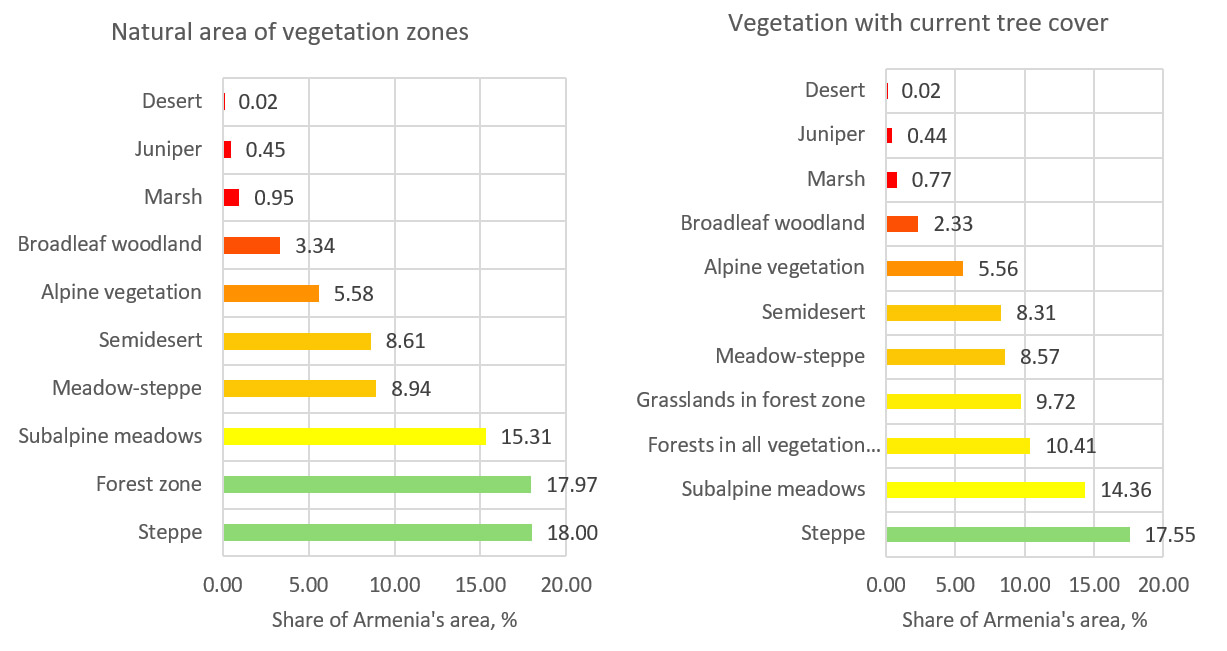
Figure 6. Ranking of vegetation types by rarity: a) natural area of vegetation zones; b) vegetation with current tree cover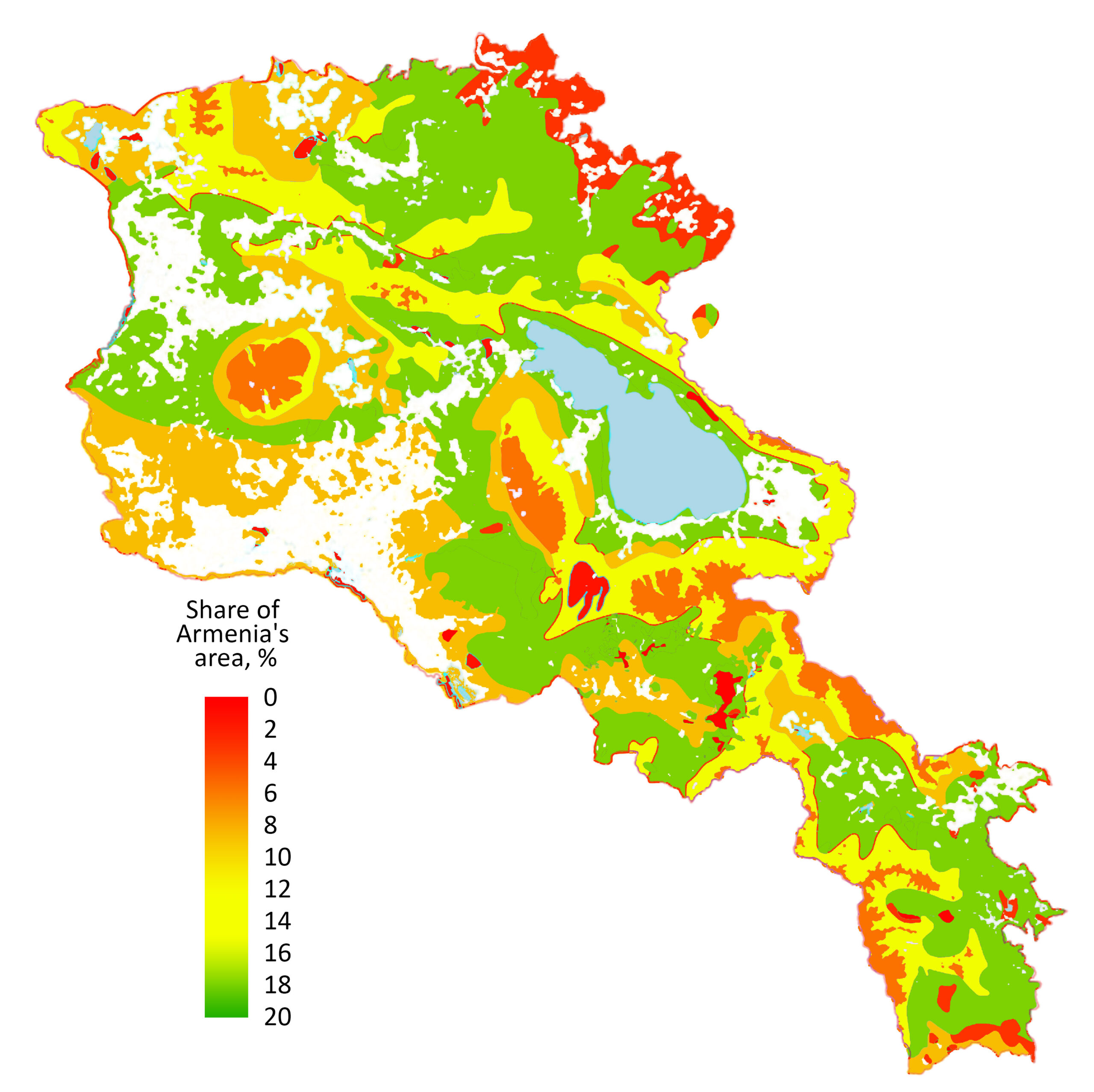
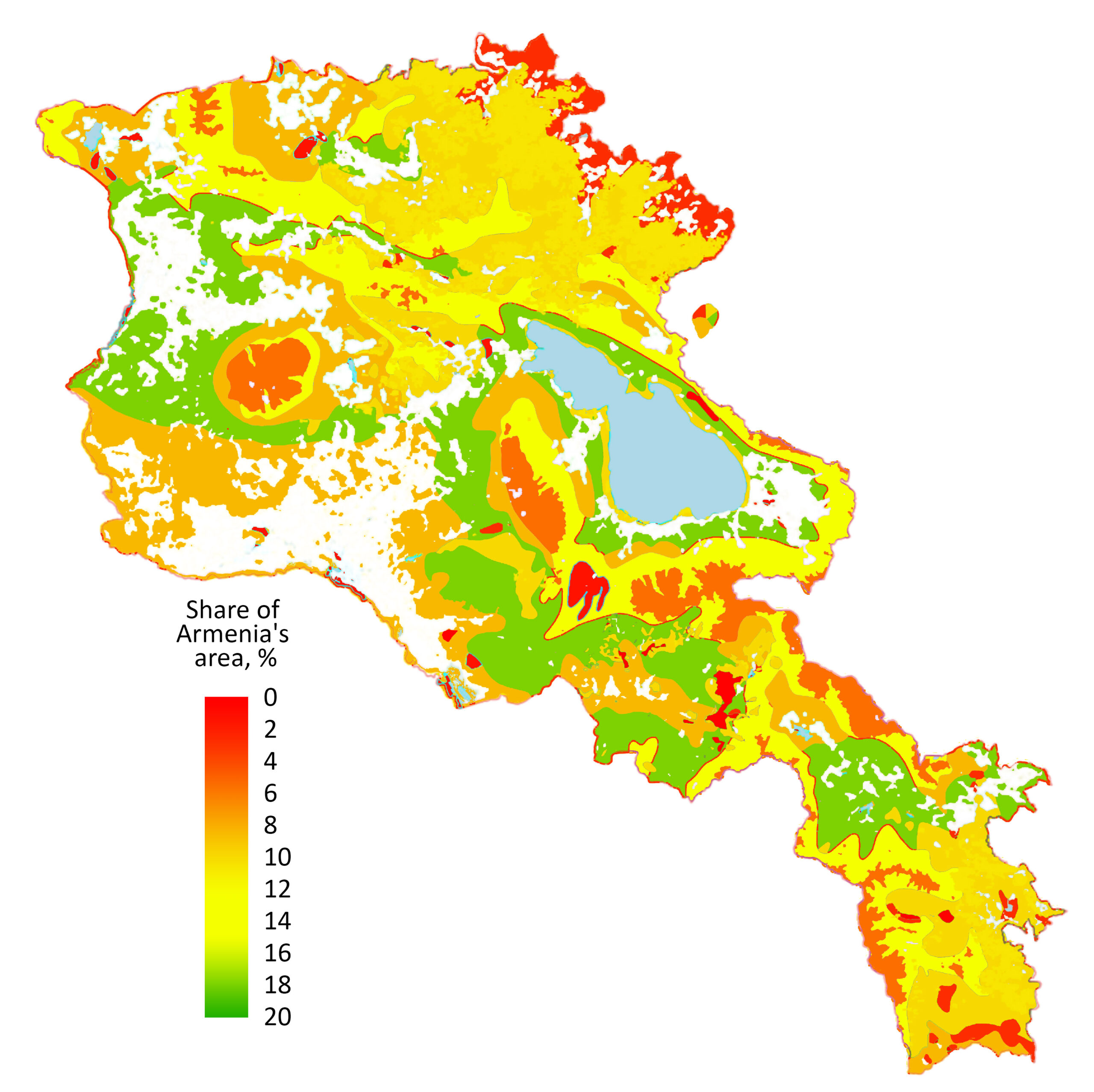
Figure 7. Rarity maps: a) natural area of vegetation zones; b) vegetation with current tree cover
3. Changes in natural area of vegetation zones from 2017 to 2023
From 2017 to 2023, natural area of all vegetation zones decreased due to expansion of croplands and built-up areas. The only exception is the broadleaf woodland zone, where anthropogenic areas slightly declined, allowing more space for ecosystems. The most significant reductions, both in absolute and relative terms, occurred in the meadow-steppe and steppe zones. Figure 8. Changes in natural area of vegetation zones in Armenia in 2017 and 2023, km2
Figure 8. Changes in natural area of vegetation zones in Armenia in 2017 and 2023, km2
Table 2. Natural area of vegetation zones in Armenia in 2017 and 2023, and changes in it
| Բուսականության տեսակները | Տարածքը 2023 թվականին, կմ2 | Տարածքը 2017 թ., կմ2 | Changes, km2 | Փոփոխություններ, % համեմատ 2017 թ |
| Ալպիական մարգագետիններ և գորգեր | 1660.84 | 1662 | -1.16 | -0.07 |
| Ենթալպյան մարգագետիններ | 4552.95 | 4601.92 | -48.97 | -1.06 |
| Մարգագետնատափաստան | 2658.2 | 2906.94 | -248.74 | -8.56 |
| Տափաստանային | 5352.42 | 5571.67 | -219.25 | -3.94 |
| Գիհի | 135.2 | 135.38 | -0.18 | -0.13 |
| Անտառ | 5345.91 | 5394.29 | -48.38 | -0.90 |
| Լայնատերեւ անտառ | 993.16 | 985.22 | 7.94 | 0.81 |
| Կիսաանապատ | 2560.1 | 2575.06 | -14.96 | -0.58 |
| Անապատ | 6.89 | 7.11 | -0.22 | -3.09 |
| Մարշ | 282.79 | 291 | -8.21 | -2.82 |
4. Marz level
The natural extent (i.e., the area not occupied by croplands or built-up areas)of vegetation zones is greatest in Syunik marz and smallest in Armavir marz (Figure 9). The forest zone (including forests and grasslands within the boundaries of the forest vegetation zone) occupies the largest areas in the provinces of Lori, Syunik, and Tavush. Alpine and subalpine zones are most extensive in Syunik and Gegharkunik marzes. Steppe and meadow-steppe occupy substantial areas across all marzes except Armavir and Tavush, with the greatest extents in Gegharkunik and Shirak. The largest areas of natural semidesert have been preserved in the provinces of Aragatsotn, Armavir, and Ararat. 
Figure 9. Natural area of vegetation zones by provinces in 2023
Changes in the natural area of vegetation zones from 2017 to 2023 are small in absolute terms—on the order of tens of square kilometers or less. The most noticeable losses of natural area occurred in the steppe and meadow-steppe zones, especially in the provinces of Shirak, Gegharkunik, and Lori. However, when expressed as the share of area lost or gained relative to 2017, the gain of open woodlands in Gegharkunik and the loss of marshes in Shirak and Aragatsotn become evident (Fig. 10).
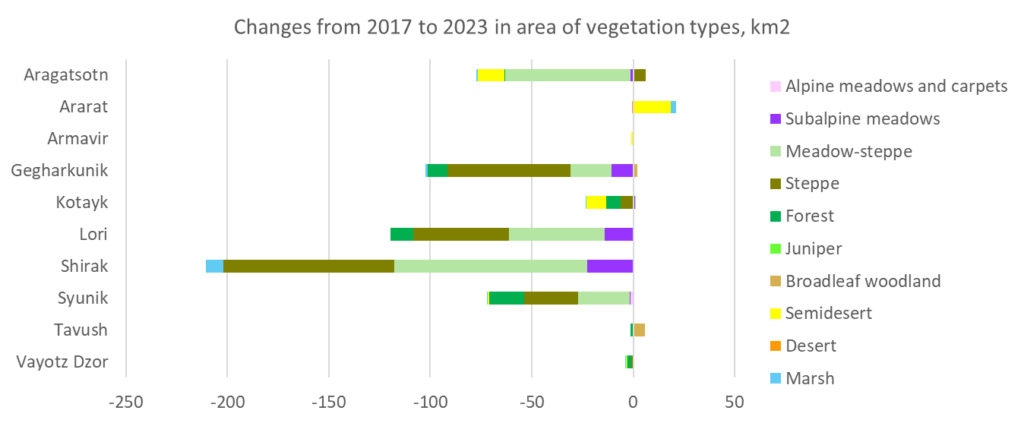
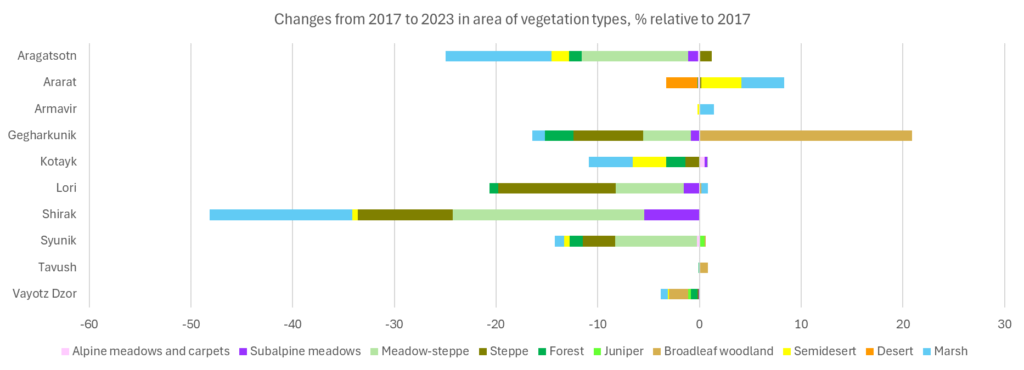
| Տարածքը 2017 թ., կմ2 | Տեսակներ | Արագա-ծոտն | Արարատ | Արմավիր | Գեղարքունիք | Կոտայք | Լոռի | Շիրակ | Սյունիք | Տավուշ | Վայոց ձոր |
| Ալպիական մարգագետիններ և գորգեր | 202.91 | 37.22 | 0 | 391.14 | 113.09 | 44.06 | 126.15 | 531.77 | 0.31 | 212.53 | |
| Ենթալպյան մարգագետիններ | 107.04 | 64.63 | 0 | 1318.69 | 207.76 | 918.78 | 420.54 | 878.41 | 275.63 | 390.67 | |
| Mea-dow-տափաստան | 586.56 | 30.74 | 0 | 425.1 | 234.72 | 703.85 | 503.67 | 320.9 | 0 | 78.76 | |
| Տափաստանային | 519.54 | 751.04 | 0 | 884.92 | 458.07 | 410.25 | 903.53 | 830.27 | 11.81 | 774.26 | |
| Անտառ | 49.49 | 187.2 | 0 | 343.67 | 377.1 | 1235.36 | 0 | 1354.65 | 1542.98 | 282.16 | |
| Գիհի | 0 | 0 | 0 | 20.6 | 0 | 0 | 0 | 13.67 | 0 | 101.06 | |
| Լայնատերեւ փայտահող | 0 | 9.46 | 0 | 8.8 | 1.68 | 73.27 | 0 | 163.98 | 696.06 | 4.74 | |
| Կիսաանապատ | 756.42 | 453.14 | 456.89 | 0 | 288.68 | 0 | 17.25 | 116.41 | 0 | 370.26 | |
| Անապատ | 0 | 7.11 | 0 | 0 | 0 | 0 | 0 | 0 | 0 | 0 | |
| Մարշ | 7.87 | 61.66 | 7.62 | 94.09 | 8.55 | 31.68 | 61.9 | 13.07 | 0 | 1.48 | |
| Տարածքը 2023 թվականին, կմ2 | Արագա-ծոտն | Արարատ | Արմավիր | Գեղարքունիք | Կոտայք | Լոռի | Շիրակ | Սյունիք | Տավուշ | Վայոց ձոր | |
| Ալպիական մարգագետիններ և գորգեր | 202.59 | 37.16 | 0 | 391.05 | 113.68 | 44.06 | 126.14 | 530.55 | 0.31 | 212.47 | |
| Ենթալպյան մարգագետիններ | 106.04 | 64.63 | 0 | 1307.91 | 208.24 | 904.53 | 397.7 | 878.07 | 275.54 | 390.5 | |
| Mea-dow-տափաստան | 524.94 | 30.77 | 0 | 405.23 | 234.95 | 656.93 | 408.82 | 295.18 | 0 | 78.74 | |
| Տափաստանային | 525.73 | 751.66 | 0 | 824.14 | 451.72 | 362.86 | 819.41 | 803.66 | 11.81 | 773.48 | |
| Անտառ | 48.88 | 187.13 | 0 | 334.03 | 370.1 | 1224.23 | 0 | 1337.58 | 1541.85 | 280.41 | |
| Գիհի | 0 | 0 | 0 | 20.62 | 0 | 0 | 0 | 13.74 | 0 | 100.79 | |
| Լայնատերեւ փայտահող | 0 | 9.46 | 0 | 10.63 | 1.68 | 73.41 | 0 | 164.17 | 701.92 | 4.65 | |
| Կիսաանապատ | 743.31 | 470.97 | 456.02 | 0 | 279.08 | 0 | 17.15 | 115.78 | 0 | 369.73 | |
| Անապատ | 0 | 6.89 | 0 | 0 | 0 | 0 | 0 | 0 | 0 | 0 | |
| Մարշ | 7.05 | 64.27 | 7.73 | 92.94 | 8.18 | 31.88 | 53.23 | 12.95 | 0 | 1.47 | |
| Փոփոխություններ 2023-2017, կմ2 | Արագա-ծոտն | Արարատ | Արմավիր | Գեղարքունիք | Կոտայք | Լոռի | Շիրակ | Սյունիք | Տավուշ | Վայոց ձոր | |
| Ալպիական մարգագետիններ և գորգեր | -0.32 | -0.06 | 0 | -0.09 | 0.59 | 0 | -0.01 | -1.22 | 0 | -0.06 | |
| Ենթալպյան մարգագետիններ | -1 | 0 | 0 | -10.78 | 0.48 | -14.25 | -22.84 | -0.34 | -0.09 | -0.17 | |
| Mea-dow-տափաստան | -61.62 | 0.03 | 0 | -19.87 | 0.23 | -46.92 | -94.85 | -25.72 | 0 | -0.02 | |
| Տափաստանային | 6.19 | 0.62 | 0 | -60.78 | -6.35 | -47.39 | -84.12 | -26.61 | 0 | -0.78 | |
| Անտառ | -0.61 | -0.07 | 0 | -9.64 | -7 | -11.13 | 0 | -17.07 | -1.13 | -1.75 | |
| Գիհի | 0 | 0 | 0 | 0.02 | 0 | 0 | 0 | 0.07 | 0 | -0.27 | |
| Լայնատերեւ փայտահող | 0 | 0 | 0 | 1.83 | 0 | 0.14 | 0 | 0.19 | 5.86 | -0.09 | |
| Կիսաանապատ | -13.11 | 17.83 | -0.87 | 0 | -9.6 | 0 | -0.1 | -0.63 | 0 | -0.53 | |
| Անապատ | 0 | -0.22 | 0 | 0 | 0 | 0 | 0 | 0 | 0 | 0 | |
| Մարշ | -0.82 | 2.61 | 0.11 | -1.15 | -0.37 | 0.2 | -8.67 | -0.12 | 0 | -0.01 | |
| Փոփոխություններ 2023-2017, % համեմատ 2017 թ | Արագա-ծոտն | Արարատ | Արմավիր | Գեղարքունիք | Կոտայք | Լոռի | Շիրակ | Սյունիք | Տավուշ | Վայոց ձոր | |
| Ալպիական մարգագետիններ և գորգեր | -0.16 | -0.16 | 0.00 | -0.02 | 0.52 | 0.00 | -0.01 | -0.23 | 0.00 | -0.03 | |
| Ենթալպյան մարգագետիններ | -0.93 | 0.00 | 0.00 | -0.82 | 0.23 | -1.55 | -5.43 | -0.04 | -0.03 | -0.04 | |
| Mea-dow-տափաստան | -10.51 | 0.10 | 0.00 | -4.67 | 0.10 | -6.67 | -18.83 | -8.01 | 0.00 | -0.03 | |
| Տափաստանային | 1.19 | 0.08 | 0.00 | -6.87 | -1.39 | -11.55 | -9.31 | -3.20 | 0.00 | -0.10 | |
| Անտառ | -1.23 | -0.04 | 0.00 | -2.81 | -1.86 | -0.90 | 0.00 | -1.26 | -0.07 | -0.62 | |
| Գիհի | 0.00 | 0.00 | 0.00 | 0.10 | 0.00 | 0.00 | 0.00 | 0.51 | 0.00 | -0.27 | |
| Լայնատերեւ անտառ–եւ | 0.00 | 0.00 | 0.00 | 20.80 | 0.00 | 0.19 | 0.00 | 0.12 | 0.84 | -1.90 | |
| Կիսաանապատ | -1.73 | 3.93 | -0.19 | 0.00 | -3.33 | 0.00 | -0.58 | -0.54 | 0.00 | -0.14 | |
| Անապատ | 0.00 | -3.09 | 0.00 | 0.00 | 0.00 | 0.00 | 0.00 | 0.00 | 0.00 | 0.00 | |
| Մարշ | -10.42 | 4.23 | 1.44 | -1.22 | -4.33 | 0.63 | -14.01 | -0.92 | 0.00 | -0.68 |
6. Reduction of the potential distribution area of 24 vegetation types identified on the 1961 vegetation map
Այս վերլուծության համար Հայկական ԽՍՀ 1961-ի ատլասի բուսականության քարտեզը (թվայնացված է. Վարդան Ասատրյան) and the ESRI land cover 2023 data were used. The current zones of vegetation types was considered as potential vegetation zones, excluding croplands and built-up areas based on ESRI data for 2023.
This analysis considers only zones of possible distribution of the vegetation types mapped in 1961. The actual presence of vegetation requires verification through field surveys.
Բուսականության քարտեզ 1961 թ
Բուսականության քարտեզ՝ բացառելով մշակաբույսերը և կառուցապատված տարածքները ESRI 2023-ից
Մանրամասն քարտեզների համար տես Բաժին Էկոհամակարգի տարածություն/բուսականություն
Ranking of vegetation types by their current rarity shows that, at present, all desert types (1–5) as well as steppe with dominance of Bothriochloa (type 7) are the rarest. Each of them occupies less than 100 km². The potential distribution areas of the two rarest desert types (2 and 4), each occupying less than 10 km², have largely preserved and mostly not covered by croplands or built-up areas according to ESRI data. The distribution area of steppe with dominance of Bothriochloa (7) also appears to be relatively well preserved.
The most severely affected was the distribution area of desert with dominance of Achillea (3), of which only 7% remains, as well as desert with Salsola dendroides (5), with only 16% remaining. The distribution area of desert with dominance of Halocnemum (1) has also been significantly reduced, with 43% remaining. These three vegetation types have experienced the greatest decline among all types shown on the map.
Relatively rare vegetation types occupying between 100 and 200 km² — deciduous and juniper open woodland (12, 13) and variants of oak forests (16, 17) — have relatively well-preserved distribution areas, with 85–99% remaining.
Among the more widespread vegetation types, occupying between 200 and 1,000 km², a significant reduction was observed only for sedge bogs and wet meadows (type 24), which declined to 63%. The distribution areas of other types — subnival vegetation, subalpine open woodlands, variants of oak and birch-oak forests, as well as shrublands — have been largely unaffected by human activity, with 94–100% of their area remaining intact.
Among the common and widespread vegetation types occupying more than 1,000 km², significant reductions have occurred in semi-desert with dominance of Artemisia (type 6) with 57% remaining and the most widespread vegetation zone – grass and forb-grass steppes (type 8) with 75% remaining, both of which are located in areas of arable agriculture.
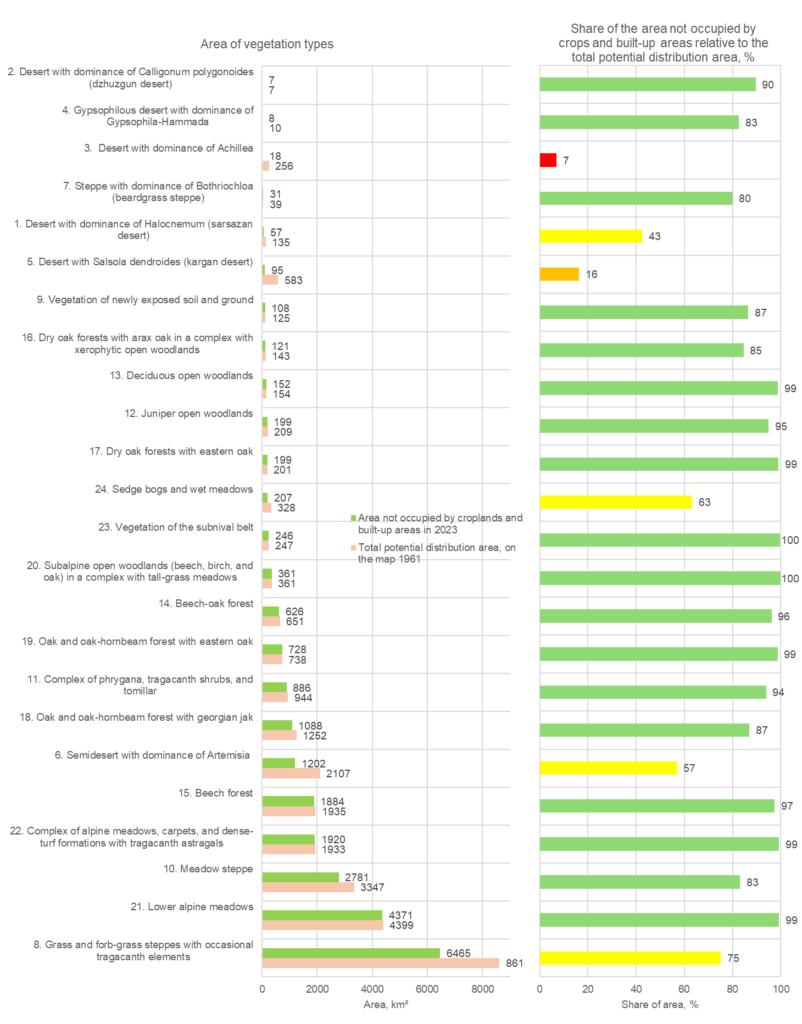
| Ընդհանուր պոտենցիալ տարածման տարածքը քարտեզի վրա 1961 թ., կմ2 | Area not occupied by croplands and built-up areas in 2023, km2 | Share of the area not occupied by croplands and built-up areas relative to the total potential distribution area, % | |
| 1. Desert with dominance of Halocnemum (sarsazan desert) | 135.1 | 57.5 | 42.5 |
| 2. Desert with dominance of Calligonum polygonoides (dzhuzgun desert) | 7.4 | 6.6 | 89.6 |
| 3. Desert with dominance of Achillea | 256.0 | 17.6 | 6.9 |
| 4. Gypsophilous desert with dominance of Gypsophila-Hammada | 9.8 | 8.1 | 82.6 |
| 5. Desert with Salsola dendroides (kargan desert) | 582.7 | 95.3 | 16.4 |
| 6. Semidesert with dominance of Artemisia | 2107.2 | 1201.5 | 57.0 |
| 7. Steppe with dominance of Bothriochloa (beardgrass steppe) | 39.1 | 31.3 | 80.0 |
| 8. Խոտածածկ և խոտածածկ տափաստաններ՝ երբեմն տրագականտի տարրերով | 8614.1 | 6464.9 | 75.1 |
| 9. Նոր բացված հողի և հողի բուսականությունը | 124.5 | 107.8 | 86.6 |
| 10. Մարգագետնային տափաստան | 3347.4 | 2781.2 | 83.1 |
| 11. ֆրիգանայի, տրագականտի թփերի և տոմիլարի համալիր | 944.1 | 886.5 | 93.9 |
| 12. Գիհու բաց անտառներ | 209.5 | 198.9 | 94.9 |
| 13. Տերեւաթափ բաց անտառներ | 153.5 | 151.6 | 98.8 |
| 14. Հաճարենու-կաղնու անտառ | 650.5 | 625.7 | 96.2 |
| 15. Beech forest | 1934.6 | 1884.0 | 97.4 |
| 16. Dry oak forests with arax oak in a complex with xerophytic open woodlands | 143.1 | 121.1 | 84.6 |
| 17. Dry oak forests with eastern oak | 200.9 | 199.1 | 99.1 |
| 18. Կաղնու և կաղնու բոխի անտառ վրացական ջակով | 1252.1 | 1088.1 | 86.9 |
| 19. Կաղնու և կաղնու-բոխու անտառ՝ արևելյան կաղնու հետ | 737.8 | 728.2 | 98.7 |
| 20. Ենթալպյան բաց անտառներ (հաճարենի, կեչի և կաղնի) բարձր խոտածածկ մարգագետիններով համալիրում | 360.6 | 360.5 | 100.0 |
| 21. Ստորին ալպիական մարգագետիններ | 4398.9 | 4370.6 | 99.4 |
| 22. Ալպիական մարգագետինների, գորգերի և խիտ խոտածածկ գոյացությունների համալիր տրագականթ աստղագալներով | 1932.9 | 1919.6 | 99.3 |
| 23. Ենթամաշկային գոտու բուսականություն | 246.7 | 245.7 | 99.6 |
| 24. Ծիծեռնակային ճահիճներ և թաց մարգագետիններ | 327.8 | 207.2 | 63.2 |
* Atlas of the Armenian Soviet Socialist Republic. Ed. Baghdasaryan A.B., Davtyan G.S., Harutyunyan A.B., Martirosyan G.M., Marukhyan A.G., Mkrtchyan S.S., Shakhbazyan M.S., Stepanyan L.A. (chairman), Urusov V.V. Academy of Sciences of the Armenian SSR. Main Directorate of Geodesy and Cartography. Yerevan – Moscow, 1961
Barseghyan A. Armenian flora. In: Armenian National Atlas, A series. 2007